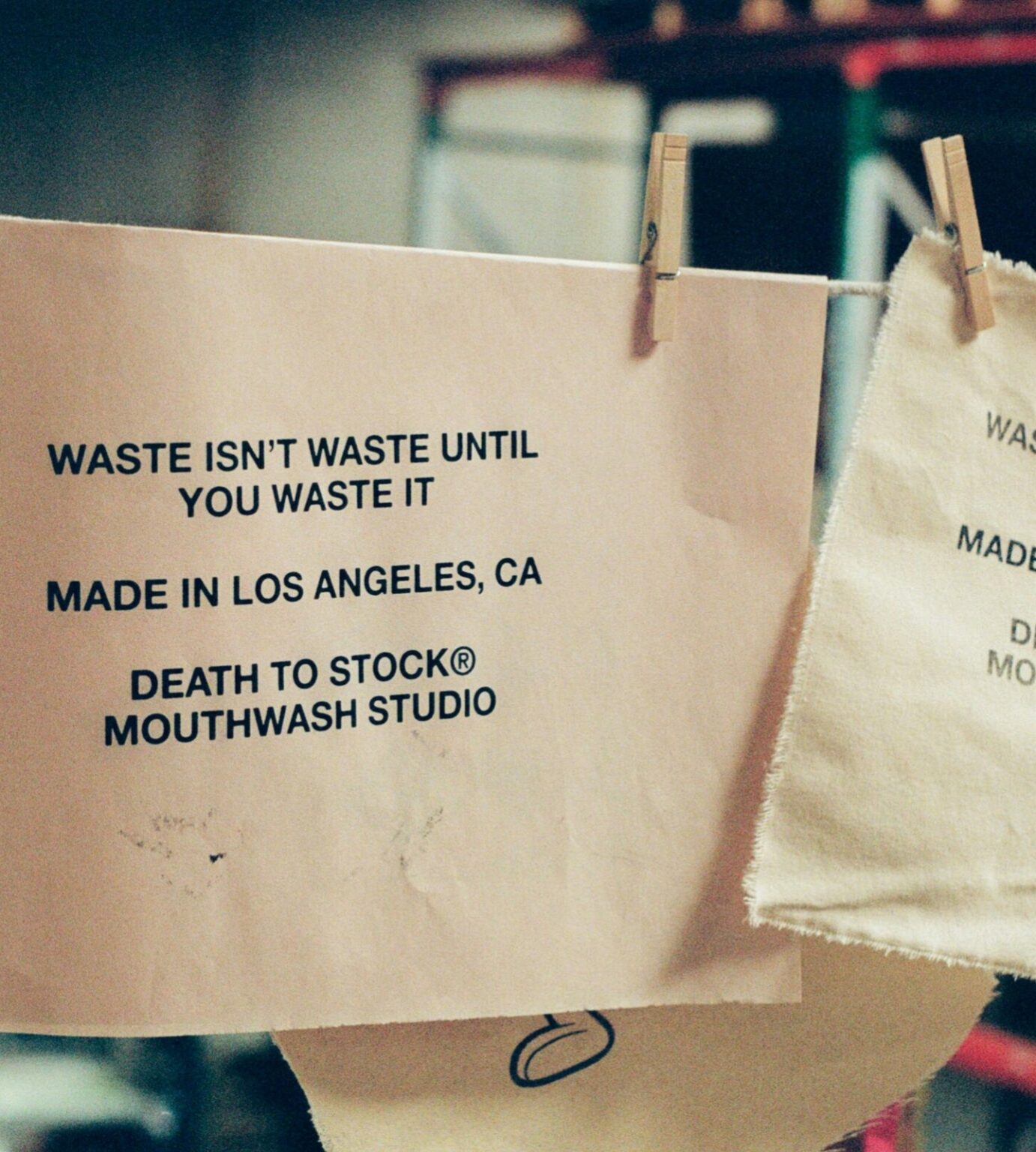The Pursuit of Happiness
When it comes to purchasing products, what is a sustainable consumer? What is a conscious consumer? And what are we actually looking for when we say we want meaning in the products we bring home?

Words:
Kate Swanson
Photography:
Lauren Mancke
The enduring human search for happiness takes many forms — we strive to eat healthy, live more sustainably, and reduce the meaningless clutter in our homes. The common thread uniting these disparate and seemingly unconnected acts may be our desire to be more thoughtful, more deliberate citizens; more thoughtful, more deliberate consumers.
But what does it actually mean to engage in a more deliberate, some might say conscious, form of consumerism? Does it mean we buy nothing? Does it mean we buy less? Does it mean that, when we do make a purchase, we deliberately seek out meaningful pieces — pieces that complement the life we want to live, both from a functional and ethical perspective? Do our purchasing decisions set off a chain reaction in the world of product creation — telling makers to make things that fit within the life we aspire to?
Perhaps, somewhere herein, lies the truth behind our pursuit of happiness.
“Money can’t buy me happiness // But I’m happiest when I can buy what I want, anytime that I want.”Jelleestone
Jelleestone was a prophet
When Canadian rapper Jelleestone penned these words, little did he probably know how prescient his lyrics would prove to be. It was August 2001 and the world was practically unrecognizable to the one around us today. Apple had not yet released the iPod (let alone the iPhone) and online shopping was a novelty. Free streaming of music and video was unheard of, with most people choosing to download media illegally through Napster. Sears was a dominant retailer, China had yet to enter the World Trade Organization, and developed countries still had manufacturing jobs. In 2001, the acquisition of goods and services in ever-increasing quantities, ever-faster and ever-quicker, was not just an expression of material prosperity around us. Indeed, consumerism was seen as the ultimate expression of human freedom, equality, and status.
Looking from the outside-in, we as a society seemed better off than ever before. We were buying more — more products, more food — in a race with our neighbours to see who won the battle of owning the next “best thing”. The age of industrialization increased the availability and decreased the cost of owning a t-shirt. So clearly, the next natural step was to buy it. As a society, we were less concerned about what had to be done to deliver a product to us, we just wanted to have it — and have more of it.
Fast-forward to 2019 and the on-demand economy we live in today is a world that Jelleestone would have probably approved of. Netflix, Spotify, Uber, Doordash, iPhone, Google, Amazon, InstaCart, Zara, H&M — are all multi-billion dollar examples of the seismic shift in consumerism over nearly two decades. The most unadulterated global shopping binge in human history lifted more people out of poverty, faster than in any other period in human history; many regions of China, South-East Asia, and India that were mired in squalor barely a generation ago — can now boast of a standard of living that is deemed to have a modicum of aspiration.

And yet, money can’t buy us happiness. This explosive consumerism, one could argue, is facilitated in part by the social sharing world that we live in; a world where the FOMO is real. People feel the need to buy more and buy what’s trending to make them feel like they are living their best life; a life that is “approved” and validated by everyone else.
It would be easy, therefore, to argue that consumerism has not made the world a better place to live in. Or has it?
Did money, accidentally, buy us a voice?
The next time you hear your friend complain about the excess packaging in a product or hear them praise that your UberEats “driver” is actually on a bicycle, take a moment to reflect on how far the modern-day consumer had come. Note, how the commentary has shifted from the action itself (consider purchasing a product with in the corner store — you walk there and carry it out — versus purchasing the same product online, which is then packed in another layer of packaging to be shipped) to that of the choices being made by the corporation behind it all and who should be more “responsible” in how they provide the product or service.
Note the subtle change in the original interpretation of the adage “one dollar, one voice”. While consumerism may have started as an expression of human freedom and equality, it has evolved to mean something quite different. Perhaps now, it would be more accurate to term the phrase as representative of the sentiment “Each dollar has a voice”.
And that voice is calling the flag-bearers of consumerism — the manufacturers, the retailers, the tech unicorns — to listen to their customers and be conscious of how the business choices they make impact the entire world around them. What decades of regulation and global agreements may have failed to accomplish, consumers, putting their money where their mouth is, are doing in far less time.
Today more and more packaging is made using recycled cardboard; grocery retailers across much of North America and Europe encourage the use of reusable bags; ever more produce is organic and ever more meat and dairy is antibiotic and hormone free; one of the fastest growing automobile companies is an electric vehicle manufacturer. And what has made it possible is consumers shunning individual responsibilities for their choices and making the entire ecosystem responsible. Accomplished without regulation or “nudge economics”. What the consumer is in effect saying is, “I did not get to buy the ethically raised, hormone-free chicken I wanted, because you, Mr. Grocery Retailer, did not do enough to make it available to me at a reasonable price. I should not have to choose between my budget and my ethics.”
Consumerism, in a way, has made consumption, more conscious.


So, are we past peak consumerism?
Ummmm…not quite. Consumer aspiration is still sky high and there is an entire developing world of consumers whose needs and wants are yet to be fully articulated and fulfilled. Yet, at least in the developed world, generational shifts coupled with a secular ascendance of urban living, are forcing consumers and brands alike to revisit cherished belief systems. The average person’s tendency to buy likely hasn’t changed — but they are now more particular about where they spend their dollar, based on what that corporation stands for.
Take, for example, the trend towards vegetarianism and veganism. While it has never been uncommon to hear a friend say they have sworn off meat, we increasingly hear those close to us say they’re reducing consumption in an effort to reduce their own carbon footprint and encourage sustainable farming practices. In this vein, meat lovers may not give up eating meat entirely, but make a conscious effort to eat less and better quality, more ethically raised, meat in an effort to do their part.
As another example, while the trend towards online shopping is showing no signs of abating, shoppers are demanding more sustainable packaging options to minimize the ecological impact of their shopping behavior.
Similarly, we’re seeing more brands push products made from recycled materials (Everlane’s 2018 splashy launch of ReNew — sweaters and jackets made from recycled plastics). But, hold on. Fun fact: recycled plastics have been used to create polyester for decades, but it is only in recent years we’ve seen a push from brands to specifically highlight their use of recycled materials. What the consumer cares about and how that translates into dollars spent becomes increasingly important to the corporation’s bottom line: success and reputation.
With the right demand, we can only expect these trends to continue. Simply put, consumerism has, in a way, made consumption more conscious. Now, I’ll have my almond-milk latte in my reusable KeepCup, thank you very much.
All things said and done, purist followers of a more sustainable lifestyle may very well call out what we’ve outlined above as a sham: the world simply cannot absorb billions of meat eaters, and ethically raised meat is not enough; we need to stop, cold turkey. (No pun intended.) Re-engineering packaging to eliminate plastics is not going to turn back the damage we’ve done by filling landfills with non-compostable plastic waste — the only path forward is to dramatically reduce (if not completely eliminate) mindless consumption.
Are we still miles apart here?
Maybe not. Perhaps the differences between those preaching sustainability and those advocating for continued consumerism are not as stark as one might think. It is reasonable to argue that the end objectives of both sides are aligned — both sides believe in a better quality of life and value immersing themselves in a better environment. Perhaps the difference lies in the way each side sees the role of humans and how humans interact with the objects they surround themselves with.
“The conflict between these visions is not between good and evil, but between different ideas of the good life, between ethical orders that give priority to personal liberty and those that give priority to what might be called connection.”Charles Mann

Tidying Up with Marie Kondo
The Japanese lifestyle phenomenon, Marie Kondo, and her KonMari Method for tidying your home is yet another testament to how consumerism is changing. Her 2011 book — The Life-changing Magic of Tidying Up — was a New York Times bestseller and her Netflix series — Tidying Up — is a huge hit. Fans of her KonMari process, which teaches one to tidy by category and advocates keeping only items that spark joy, swear to the life-changing nature of their results.
KonMari, when done properly, should leave you with only the things you need and eliminate that which does not bring joy to your life. Taken further, her practice helps you think more critically about future purchases, asking yourself whether a given item will ultimately add joy to you when it enters your space.
Yet while watching the admittedly addictive Netflix series, one cannot help but wonder, why now? Why is this so popular today?
Is it popular only amongst Millennials? (oh Millennials, your supposed preference for all things experiential instead of disposable, physical items must make this an easy philosophy to get behind!) Ummm no…. Millennials love their stuff, which they are busy tidying up using the KonMari Method.
Is it because of the trend towards small-space living has placed a premium on storage space? (If you live within 10 miles of the city centre, chances are you’re living in a condo, apartment, or small house, and don’t exactly have empty closets and cupboards waiting to be filled.) Not entirely…
Small-space living is definitely on the rise, but the trend is by no means new, and people have been cramming themselves into downtown digs for decades without radically changing their patterns of consumption.
A more likely reason is the deeper motivation of the individual themself, as they feel the forces from different parts of their life colliding in the space they call home.
In Marie Kondo’s book, she asked one client why she wanted to declutter her home. The client replied, “Well, when I come home from work, the floor would be clear of clutter… and my room, as tidy as a hotel suite with nothing obstructing the line of sight. I’d have a pink bedspread and a white antique-style lamp. Before going to bed, I would have a bath, burn aromatherapy oils, and listen to classical piano or violin while doing yoga and drinking herbal tea. I would fall asleep with a feeling of unhurried spaciousness.”
Our takeaway: Marie Kondo’s disciple wants to create an environment that feels right; an environment that brings peace and solitude, that connects her to the world, and that satisfies her internalized understanding of herself.
And yes, that means creating a room which sparks the right feeling, and that room probably needs to be tidy in order make that feeling a reality. But can all this be achieved through one bout of KonMari magic? Maybe.
One could argue that many of us grew up in a world of consumerism, and those influences over our purchasing habits are hard to change, even though we’ve tidied our apartments and homes. A pessimistic view is that even after donating and tidying our belongings, we will probably still buy more products, which will inevitably take up the space that they once did. Habits are tough to change, aren’t they?
An optimistic spin on this is that perhaps the average consumer today will be asking more from the products they buy and the corporations they buy from. Can what I own not only look good, but make me feel good about how it was made, and function in a way that suits my lifestyle, rather than distract or detract from it?

So, perhaps what is more important, and what Marie Kondo stresses, is that achieving that life changing magic is not simply about the motivation to be tidy, but the motivation to have the right things. Let me say this again. The right things.
Note how the client still wanted the pink bedspread (thanks, Parachute). And the white antique-style lamp (hours spent sourcing from a million furniture stores — worth it.). And the aromatherapy oils (burned in the perfect diffuser.). And the herbal tea (in her favourite ceramic mug). And wanted to listen to classical piano or violin (probably on Spotify, perhaps from a minimalist Sonos speaker, or through easy to store wireless AirPods?). And do yoga (Maybe Lululemon pants? An Outdoor Voices top? She’ll also need the right yoga mat, one that is rolled perfectly in the corner.).
Marie Kondo’s client does not necessarily want to stop buying things, but she is hyper aware that her ideal space requires the right things. She wants to be conscious of the things she brings into her home. She wants to buy fewer, better, things (Cuyana, you say this so well, so we’re borrowing your tag line). Things that spark joy. Things that fit her life. Things that fit her space.
Products that support, not detract, from the life we want
Perhaps what we are actually observing is a world where consumerism makes consumption more conscious. Maybe the next wave of consumerism will be fuelled not by a desire to simply have more, but by a desire to truly connect — on a myriad of levels — with the things we purchase and the things we bring into our homes. In doing so, it is possible we’ll reduce generic purchasing in lieu of deliberately selecting meaningful pieces; products that we love that compliment the life we want to live, from both a functional and ethical perspective.
Perhaps we will seek-out better products. And perhaps, through our purchasing power, we’ll prompt product makers to head back to the drawing board and reimagine what is possible from a product. Rethink the way products are made. And, ultimately, create thoughtfully designed products that are capable of sparking joy while fitting against the backdrop of a conscious life.
Perhaps that is what the pursuit of happiness looks like.

More Stories
-
 17.11.2025 | News
Black Friday Sale - 45% off everything *including Stackware*
17.11.2025 | News
Black Friday Sale - 45% off everything *including Stackware*
Our biggest (and only) sale of the year is here. Over $460++ off cookware. 45% off everything.*
-
 05.11.2023 | News
Celebrating with Rolls-Royce
05.11.2023 | News
Celebrating with Rolls-Royce
Bringing design, innovation, sustainability, performance, luxury, and craftsmanship together.
-
 01.11.2023 | News
Utility Patent Granted
01.11.2023 | News
Utility Patent Granted
The ENSEMBL: Stackware Removable Handle has received a utility patent.
Free shipping on all North American orders.